SILVANA MOSSANO
Reportage udienza 4 aprile 2022
Quesito numero 1: Stephan Schmidheiny era consapevole che le risorse investite negli stabilimenti Eternit in Italia erano insufficienti a ridurre la polverosità nei luoghi di lavoro?
Quesito numero 2: Stephan Schmidheiny ha evitato, per mero fine di lucro, di stanziare i soldi necessari a una radicale revisione degli impianti e delle procedure di lavoro nelle fabbriche, e ha invece attuato una politica aziendale che, giocoforza, ha implicato una ingente e fatale esposizione ad amianto di lavoratori e cittadini?
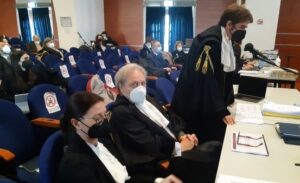
Dare la risposta a questi due interrogativi è stato il compito affidato ai consulenti Stefania Chiaruttini e Luca Minetto dagli avvocati Astolfo Di Amato e Guido Carlo Alleva, difensori dell’imprenditore svizzero Schmidheiny nel processo Eternit Bis, che si sta svolgendo in Corte d’Assise a Novara. L’imputato deve rispondere dell’omicidio doloso di 392 casalesi e monferrini morti a causa della diffusione incontrollata di amianto, la cui fibra provoca il cancro maligno chiamato mesotelioma.
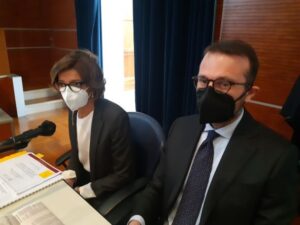
Dai curricula dei due esperti, commercialisti con sede a Milano, emerge una grande e provata esperienza nello studio e nella gestione di patologie e crisi di aziende; in questo ambito, hanno svolto consulenze tecniche a favore sia di pubblici ministeri, sia di difensori penalisti sia di enti. Sono autori di numerose pubblicazioni e relatori in convegni.
«Condotta corretta»
Per Chiaruttini e Minetto l’«azionista svizzero di riferimento», mai citato con nome e cognome, ha tenuto una condotta complessivamente corretta, rispetto al «contesto economico e regolatorio dell’epoca». E’ stato questo il punto di partenza della loro relazione, che ha impegnato complessivamente tre ore all’udienza del 4 aprile.
«Valutare con gli occhi di allora»
«La società Eternit ha indiscutibilmente rappresentato un pezzo importante della storia industriale del nostro Paese» hanno esordito.
Il primo stabilimento in Italia fu aperto a Casale nel 1907 e fu attivo per ottant’anni. Quindi, hanno messo in chiaro i consulenti, l’esame delle vicende societarie dell’Eternit va collocato nel contesto economico e regolatorio di quel periodo; in altre parole, bisogna «osservare “con gli occhi di allora” i vari fenomeni succedutisi all’epoca».
Occorre anche aggiungere una precisazione che vale tanto per il lavoro dei consulenti della difesa quanto per quello omologo del consulente della procura Paolo Rivella: le analisi economiche, finanziarie e contabili svolte hanno dovuto, per certe parti, essere desunte da stime o proiezioni, perché una cospicua parte della documentazione contabile andò letteralmente a bagno, distrutta anni fa in seguito all’allagamento dei locali in cui era custodita a Genova. A Genova, c’era la sede legale di Eternit Italia.
Il contesto storico
L’epoca da mettere a fuoco va dal 1976 al 1986, il cosiddetto «periodo di garanzia» di cui l’imputato è chiamato a rispondere, cioè il decennio in cui fu il gestore dell’Eternit.
In realtà, Chiaruttini e Minetto sono partiti un po’ più indietro per analizzare il contesto storico, in particolare dal 1972 quando, a fronte della situazione di difficoltà in cui versava l’azienda, si decise di attuare un piano di ristrutturazione. Furono gli azionisti svizzeri, che facevano capo alla famiglia Schmidheiny, a farsene carico, mentre i belgi, contrari a metter soldi dubbiosi su possibili prospettive lusinghiere, via via si defilarono. Fu così che, nel 1973, il Gruppo svizzero divenne l’azionista di riferimento per l’Eternit in Italia, con stabilimenti a Casale, Bagnoli di Napoli, Siracusa e Rubiera dell’Emilia. Allora, a capo del gruppo c’era ancora Max Schmidheiny, anche se testimonianze e documenti già attestava la presenza attiva del figlio Stephan, cui il padre assegnò formalmente il settore amianto appunto dal 1976.
La crisi degli anni Settanta
I consulenti hanno ricostruito la crisi generalizzata che caratterizzò l’inizio degli anni Settanta (hanno consegnato alla Corte anche degli articoli del Sole24Ore, tra cui uno recentissimo uscito domenica 3 aprile, in cui si richiama proprio quell’epoca per fare un paragone con le criticità dei giorni nostri). La crisi era determinata dall’aumento dei prezzi della materia prima e dei costi dell’energia, «un po’ come adesso», dall’elevato «costo del denaro che riguardò tutto il mondo delle imprese in quegli anni», oltre che dalla «mancanza di una politica industriale da parte del Governo» che, hanno rimarcato i due esperti, si limitò, e solo nel 1984, alla dichiarazione dello stato di crisi del settore da parte del Ministero del Lavoro.
Piano di ristrutturazione
E in questo contesto che cosa decide il Gruppo Svizzero? «Supporta finanziariamente, sotto diverse forme, il Gruppo Eternit Italia». Perché? Per Chiaruttini e Minetto «al solo fine di raggiungere l’obbiettivo che si era posto nel 1972, ossia una ristrutturazione dal punto di vista industriale, riportando l’Eternit Italia ai livelli di redditività passati e, attraverso un’importante politica di investimento, creare delle condizioni di vantaggio competitivo a lunga durata rispetto ai concorrenti» (principalmente Fibronit e Italtubi, benché di dimensioni inferiori). In altre parole, gli svizzeri intervennero attuando «una stretta sui costi, una politica commerciale più forte rispetto al passato, la formazione dei manager e, soprattutto, con finanziamenti e investimenti imponenti». La difesa ha evidenziato un impegno complessivo di oltre 84 miliardi di lire.
Diversa l’interpretazione fornita dal consulente della procura, Rivella: la tenace volontà del Gruppo svizzero di immettere risorse per tirar su il Gruppo Italiano, «nonostante le grosse perdite generate», a suo giudizio era motivata dalla volontà degli svizzeri di «mantenere il monopolio sul mercato europeo e impedire l’ingresso di altri operatori su quello italiano».
Finanziamenti
Chiaruttini e Minetto ritengono che il Gruppo Eternit Italia – poiché «non era in grado di fare fronte autonomamente» all’aumento dei costi di produzione, «al rimborso dell’indebitamento bancario contratto» per mutui e fidejussioni e «agli ingenti investimenti» reputati necessari – dovette «beneficiare degli apporti» svizzeri per un totale di oltre 84 miliardi di lire, di cui 32 in aumenti di capitale, una trentina in garanzie ai finanziamenti e fidejussioni, e una decina derivati dalla cessione delle quote (pari al 50%) dell’Amiantifera di Balangero spa.
In senso contrario, il Gruppo italiano versò in quegli anni al Gruppo svizzero complessivamente poco più di 2 miliardi e 600 milioni in dividendi e royaltes),
Amiantifera di Balangero
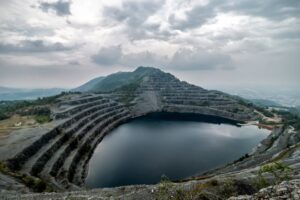
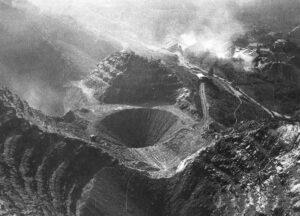
Qualche cenno storico alla più grande cava di amianto in Europa, attiva a Balangero, nel Torinese: nel 1950, le società Manifatture Colombo ed Eternit acquisirono dall’Iri le quote di proprietà, divise al 50 per cento; insieme costituirono l’Amiantifera Balangero spa, con presidente Rinaldo Colombo, imprenditore bergamasco, che per oltre 25 anni la portò ai massimi livelli di sviluppo. Morì nel 1982 e, nel 1983, fu ceduta ai fratelli Puccini di Roma.
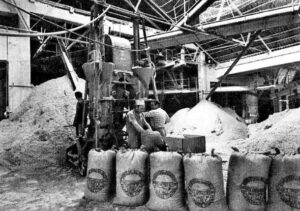
Ne seguì il declino, fino al fallimento del 1990. La vendita della partecipazione in Amiantifera fruttò al Gruppo Eternit svizzero circa 10 miliardi di lire che, secondo i consulenti della difesa, generarono cassa a favore del Gruppo italiano «e non, come afferma il consulente della procura, per depredare Eternit Italia togliendo un pezzo del gioiello di famiglia».
Investimenti
Particolare attenzione è stata dedicata dai commercialisti Chiaruttini e Minetto al capitolo degli investimenti che, secondo la loro ricostruzione ammonta a un totale di 33 miliardi e 400 milioni distribuiti sui quattro stabilimenti italiani. Secondo i consulenti della difesa coinciderebbero quasi complessivamente in investimenti che ebbero a che fare con la sicurezza nel posto di lavoro, anche se nei bilanci le voci imputate alla sicurezza non erano specificate «perché all’epoca non era previsto». Hanno sostenuto che, oltre alle spese dirette (per mascherine, pulizie, manutenzione e così via), l’ammodernamento di macchine e impianti e l’aggiornamento tecnico, come anche l’istituzione del «Sil» (organismo interno attivato dall’azienda il controllo di igiene e sicurezza sul lavoro), generava automaticamente sicurezza. In altre parole, la dotazione di apparecchiature più moderne garantiva meno polverosità e più contenuta dispersione di fibre.
E’ stato anche esemplificato un confronto con il concorrente Fibronit, il più simile in Italia a Eterni, per dimensioni: rispetto ai 33 miliardi sborsati dagli svizzeri, fece investimenti inferiori, cioè per 24 miliardi, 9 in meno. Un breve commento a margine dei dati numerici, anche se non è materia del processo Eternit Bis: il raffronto poco giova, dal momento che Fibronit, dal punto di vista della sicurezza, non viene considerato un esempio di virtù, tant’è che, specialmente a Broni e Bari, dove ha principalmente operato, si contano parecchi morti di mesotelioma. Se si deve valutare un altro numero, quello delle vittime starebbe a evidenziare che in sicurezza non si è fatto abbastanza, né in un caso né nell’altro, per scongiurarlo.
Per tornare agli investimenti di Eternit, a parere di Rivella gli ammodernamenti in macchinari erano prioritariamente finalizzati ad aumentare la produttività; invece, dei denari spesi tra il 1973 e il 1983 in modo specifico per la sicurezza, il consulente della procura aveva trovato traccia in un «foglietto» reperito nei vecchi uffici abbandonati della sede di Casale: sulla paginetta sono annotati esborsi complessivi per circa 7 miliardi e 600 milioni in Italia, «di cui 4 destinati allo stabilimento casalese».
Le ragioni degli interventi
La tesi della difesa, sostenuta e motivata dai propri consulenti, è che Schmidheiny, fosse convinto, con il sostegno finanziario di cui hanno dato conto, di riuscire a rilanciare il gruppo italiano, recuperando redditività e anche competitività rispetto ai concorrenti più piccoli. La storia non gli ha dato ragione: nell’84 la società entrò in regime di amministrazione controllata, cui seguì il fallimento nel 1986. Proprio ciò che Chiaruttini e Minetto ritengono che Schmidheiny volesse a tutti i costi evitare perché, ancor più di oggi, «in quell’epoca rappresentava un’onta, un disvalore a livello di impresa e di vita sociale».
A quell’epilogo non riuscì a sottrarsi, ma, a giudizio dei due consulenti, l’imprenditore svizzero svolse correttamente «il ruolo normale di azionista di riferimento» nei confronti di Eternit Italia, in «un settore complesso dove le linee guida dovevano essere condivise a livello mondiale». Il riferimento va anche ai manuali di comportamento cui bisognava attenersi.
Come si è mosso Schmidheiny?
Ecco, in sintesi, come viene riassunto il suo ruolo dai due consulenti.
1) Schmidheiny ha attuato un piano di sostegno con finanziamenti e investimenti, di cui Chiaruttini e Minetto hanno dato conto, il 4 aprile, con un’esposizione chiara, competente, articolata e il più documentata possibile.
2) Ha preso inconsiderazione i problemi di sicurezza del settore amianto e li ha affrontati, studiando pure l’impiego di nuove fibre alternative. La memoria di chi ha seguito il maxiprocesso Eternit 1 a Torino, però, rimanda alla testimonianza dell’ex sindaco Riccardo Coppo, quando parlò delle diverse lettere inviate a Schmidheiny, tra la fine degli anni Settanta e i primi anni Ottanta, e delle reiterate promesse ottenute in risposta circa la realizzazione di un nuovo stabilimento, sostitutivo di quello vetusto del Ronzone. Qui sarebbero state appunto utilizzate fibre alternative all’amianto. Ma gli impegni svizzeri venivano sempre procrastinati, tanto che Coppo disse: «Capimmo che ci prendevano in giro».
3) Ha formato i manager più importanti, ed «è giustissimo, si fa così ancora oggi» ha sottolineato Chiaruttini, aggiungendo che «ogni società del gruppo aveva un proprio amministratore con deleghe per effettuare scelte autonome». Un’autonomia un po’ ristretta, verrebbe da dire. Sempre attingendo alla memoria del maxiprocesso, si ricordano le lettere timbrate con la scritta «Confidential» e che costituivano il riservatissimo scambio epistolare (attraverso canali diversi da quelli su cui viaggiava la normale corrispondenza) tra l’amministratore delegato italiano Luigi Giannitrapani e Stephan Schmidheiny in persona, tra il 1975 e il 1983: dalle missive emerge il ruolo del proprietario e gestore che impartisce disposizioni al subalterno e questi dà puntualmente conto di quanto richiesto.
Prossima udienza
Lunedì 11 aprile, i consulenti Chiaruttini e Minetto si sottoporranno al controesame da parte dei pm Gianfranco Colace e Mariagiovanna Compare, e dei legali delle parti civili.
Saranno esaminati anche altri due consulenti della difesa: l’ingegner Giuseppe Nano e l’igienista ambientale Danilo Cottica.
Sentenza a Napoli
Mercoledì 6 aprile, è attesa la sentenza della Corte d’Assise di Napoli nel filone del processo Eternit Bis in cui l’imprenditore svizzero è imputato di omicidio doloso per 8 vittime di Bagnoli: 6 ex lavoratori dello stabilimento e 2 loro famigliari. I pm hanno chiesto la condanna a 23 anni e 11 mesi, i difensori hanno invocato l’assoluzione.
Translation by Vicky Franzinetti
April the 4th , 2022 Eternit Hearing Novara
Silvana MOSSANO
Question 1: Was Stephan Schmidheiny aware that the resources invested in the Eternit plants in Italy were insufficient to reduce dust in the workplace?
Question number 2: Did Stephan Schmidheiny fail to allocate the money needed for a radical overhaul of the plants and of the working procedures in the plants for reasons of mere profit, [and or?] did he [instead ?] implement a company policy that, inevitably, implied a huge and fatal exposure of workers and members of the community to asbestos?
The defense expert witnesses Stefania Chiaruttini and Luca Minetto were asked these questions by the (defense) lawyers Astolfo Di Amato and Guido Carlo Alleva, for the Swiss entrepreneur Schmidheiny in the Eternit Bis trial, which is taking place in the Court of Assizes in Novara. The defendant must answer for willful murder of 392 people from Casale Monferrato who died because of the uncontrolled spread of asbestos, whose fiber causes the cancer called mesothelioma.
The two experts are accountants based in Milan, and their CVs show a great and longstanding experience in the study and management of company problems and crises. They have been expert witnesses for Prosecutors, defense and institutions. They are authors of numerous publications and speakers at conferences.
“Correct conduct“.
For Chiaruttini and Minetto, the “Swiss reference shareholder “, never mentioned by name, behaved in what can be termed a generally correct manner, with respect to the “economic and regulatory context of the time”. This was the starting point of their report, which took up a total of three hours at the April the 4th hearing.
“Look at it through the eyes of the time”
“The Eternit company unquestionably was a major part of our country’s industrial history,” they began.
The first plant in Italy was opened in Casale in 1907 and that was active for eighty years. The expert witnesses made it clear that the Eternit’s corporate events must be examined in the economic and regulatory context of that period; in other words, one must look at what happened “ through the eyes of the time“.
A point that applies both to the work of the defense consultants and to that of the Prosecutor’s expert witness, Dr Paolo Rivella must be made: the economic, financial and accounting analyses carried out had to be inferred from estimates or projections, because a considerable part of the accounting papers were destroyed years ago following the flooding of the premises where they were stored in Genoa. The legal headquarters of Eternit Italia were in fact in Genoa.
The historical context
The period of interest is from 1976 to 1986, the so-called period di garanzia which the defendant is called to answer for, the decade when he was the Eternit CEO.
Chiaruttini and Minetto started a little further back to analyze the historical context, especially from 1972 when, faced with the difficult situation of the company, it was reorganized. It was the Swiss shareholders, headed by the Schmidheiny family, who took charge of the plan, while the Belgians, who were against putting money into the company and raised doubts about the possibility of good prospects, and gradually withdrew. Thus, in 1973, the Swiss Group became the reference shareholder for Eternit in Italy, with plants in Casale, Bagnoli di Napoli, Siracusa and Rubiera dell’Emilia. At that time, Max Schmidheiny was still at the head of the group, even though testimonies and documents already indicated his son Stephan’s active role. Max formally assigned the asbestos sector to Stephan in 1976.
The crisis in the Nineteen Seventies
The expert witnesses retraced the general crisis of the early nineteen seventies they also handed over to the Court articles from [the financial daily] Sole24Ore, including a very recent one published on Sunday, April 3, in which they refer to that period comparing it to the critical situation of today. The crisis was determined by the increase in raw material prices and energy costs, “a bit like now”, by the high “cost of loans that affected the whole business world in those years”, as well as by the “lack of an industrial policy on the part of the Government” which, the two expert witnesses remarked, was limited, and only in 1984, did the Ministry of Labor declare the industry in crisis.
Re-organization Plan
What did the Swiss Group decide given the context? “In various ways it financially supported the Eternit Italia Group”. Why? According to Chiaruttini and Minetto, “for the sole purpose of achieving the objective set in 1972, i.e., re-organizing it from an industrial point of view, bringing Eternit Italia back to past levels of profitability and, through a major investment policy, creating conditions for a long-term competitive advantage over its competitors” [mainly Fibronit and Italtubi, although they were smaller in size]. In other words, the Swiss intervened by “cutting costs, implementing a stronger commercial policy than in the past, the training of managers and, above all, with massive financing and investment”. The defense highlighted a total commitment of over 84 billion lire about 40 M €.
Rivella, the public prosecutor’s consultant, had given a different interpretation: in his opinion, the Swiss Group’s tenacious desire to invest resources in order to raise the Italian Group “despite the large losses generated” was motivated by the Swiss’s desire to “maintain a monopoly on the European market and prevent other operators from entering the Italian market”.
Financing
Chiaruttini and Minetto believe that since “it was not able to face” the increase in production costs on its own, “the repayment of the bank debt contracted” for loans and sureties and “the huge investments” deemed necessary, the Eternit Italia Group had to “benefit from the contributions” of the Swiss for a total of over 84 billion lire of the time, of which 32 billion lire in capital increases, around 30 billion lire in guarantees for loans and sureties, and around 10 billion lire derived from the sale of shares (equal to 50%) of the Amiantifera di Balangero spa [the asbestos quarry].
In fact, in those years the Italian Group paid to the Swiss Group a little more than 2 billion and 600 million in dividends and royalties.
Amiantifera di Balangero
In 1950, Manifatture Colombo and Eternit acquired 50% of the shares from IRI, and together they established Amiantifera Balangero spa. Rinaldo Colombo, a businessman from Bergamo became its president and died in 1982. In 1983, the company was sold to the Puccini brothers of Rome. A decline followed, until the company went bankrupt in 1990. The sale of the shareholding in Amiantifera earned the Swiss Eternit Group approximately 10 billion lire which, according to the defense consultants, generated cash in favor of the Italian Group “and not, as the prosecutor’s consultant states, to plunder Eternit Italia by removing a piece of the family jewel”.
Investments
The accountants Chiaruttini and Minetto focused on the investments that, according to their reconstruction, totaled 33 billion and 400 million (old Italian Lire) distributed on the four Italian plants. According to the defense consultants, these investments were almost all related to safety in the workplace, even though the balance sheets did not specify the items attributed to safety “because at the time it was not foreseen”. They argued that, in addition to direct expenses (for masks, cleaning, maintenance and so on), the modernization of machinery and equipment and technical updating, as well as the establishment of the “SIL” (company uniti for hygiene and safety at work), automatically generated safety. In other words, more modern equipment ensured less dust and less dispersion of fibers.
A comparison with competitor Fibronit, the closest in size to Eternit Italy was offered: compared to the 33 billion It Lire disbursed by the Swiss, it invested 24 billion, 9 less. A brief comment on the numerical data, even if it is not the subject of the Eternit Bis trial: the comparison is not very useful, since in terms of safety Fibronit, was not considered an example of virtue, so much so that, especially in Broni and Bari, where it mainly operated, there are very many deaths from mesothelioma. If another number were to be evaluated, that of the victims would show that not enough was done in terms of safety, in one case or another, to prevent it.
To return to Eternit’s investments, according to Rivella, the modernization of machinery was primarily aimed at increasing productivity; however, the prosecutor’s expert witness had found references on a “sheet of paper” of the money spent between 1973 and 1983 specifically for safety, in the old, abandoned offices of the Casale headquarters: a total disbursements of about 7 billion and 600 million in Italy, “of which 4 million were destined for the Casale plant”.
Why introduce these measures?
The thesis of the defense, supported and motivated by its own consultants, is that Schmidheiny was convinced that with the financial support he would succeed in relaunching the Italian group, recovering profitability and competitiveness compared to smaller competitors. History did not prove him right: in 1984 the company went into receivership, followed by bankruptcy in 1986. This is exactly what Chiaruttini and Minetto believe that Schmidheiny wanted to avoid at all costs because, even more than today, “at that time it represented a disgrace, a disvalue in terms of business and social life”.
He was not able to avoid the outcome, but, according to the two defense expert witnesses the Swiss entrepreneur correctly carried out “the normal role of the main shareholder (azionista di riferimento) ” for Eternit Italia, in “a complex industry where the guidelines had to be shared worldwide”. The reference also goes to the manuals of conduct that had to be followed. [were there any such manuals?]
What did SS do?
Here, in brief, is how his role is summarized by the two consultants.
1) Schmidheiny implemented a support plan with financing and investments, of which Chiaruttini and Minetto spoke on April the 4th, with a clear, competent, articulate and as much documented exposition as possible.
2) He took the safety problems of the asbestos sector into consideration and addressed them, even studying the use of new alternative fibers. The memory of those who followed the Eternit 1 maxi-trial in Turin, however, refers to the testimony of the former mayor Riccardo Coppo, when he spoke of the various letters sent to Schmidheiny, between the end of the nineteen seventies and the early eighties, and of the repeated promises in response about the construction of a new plant, replacing the old one in Ronzone which is where alternative fibers to asbestos would have been used. But Swiss commitments were always procrastinated, so much so that Coppo said: “We understood that they were making fun of us”.
3) He trained the most important managers, and “it’s very right, it’s still done this way today” Chiaruttini underlined, adding that “each company of the group had its own CEO to make autonomous choices”. A somewhat restricted autonomy, one might say. Still drawing on the memory of the maxi-trial, we remember the letters stamped with the writing “Confidential” and which constituted the confidential exchange of correspondence (through different channels from those through which normal correspondence traveled) between the Italian managing director Luigi Giannitrapani and Stephan Schmidheiny in person, between 1975 and 1983: the letters highlight the role of the owner and manager who instructed the subordinate and the latter gives punctual account of what has been requested.
Next hearing
On Monday, April 11, the expert witnesses Chiaruttini and Minetto will undergo cross-examination by the Public Prosecutors Gianfranco Colace and Mariagiovanna Compare, and by the lawyers of the civil parties.
Two other defense consultants, engineer Giuseppe Nano and environmental hygienist Danilo Cottica, will also be examined.

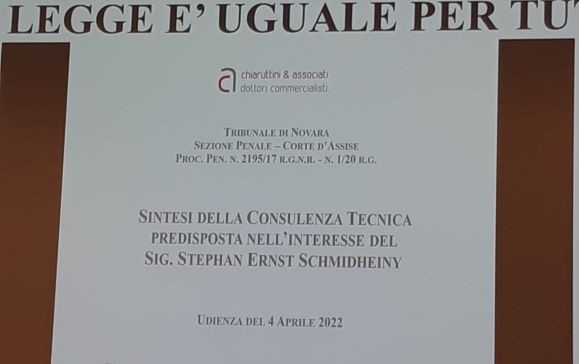
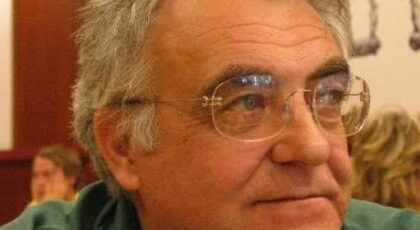
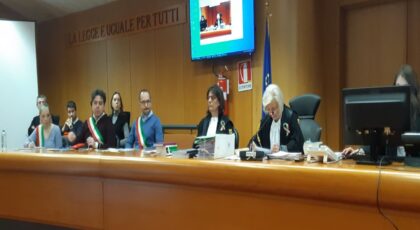
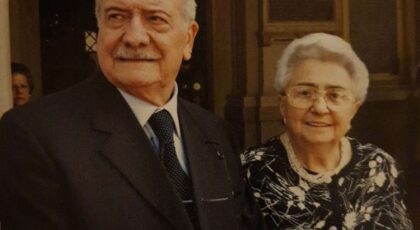
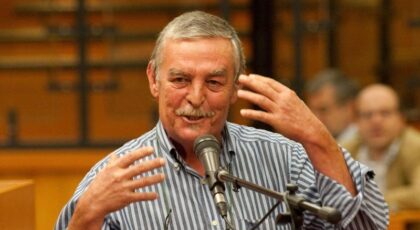
Narrativa tecnica e molto precisa . Cara Silvana avanti con questo passo non si ha più visione di un termine a breve o molto lungo della fine del processo. Solo chi non c’è più può “aspettare” ma i famigliari NO! Grazie Silvana e sempre un caro ricordo a chi ci ha preceduto nella Patria Celeste.
Grazie Silvana,
della tua precisa e puntuale rendicontazione della discussione processuale che si svolge in aula, ci dai sempre la possibilità di restare costantemente legati alla drammatica realtà di sofferenza della nostra città…devo dire che ci vuole davvero uno stomaco di ferro per affermare, mi rivolgono consulenti, che investimenti e azioni erano rivolti anche all’interesse sociale…ciao e grazie grazie per la tua costante presenza..ti abbraccio forte
Ancora grazie per le dettagliate informazioni. È triste leggere quanto emerge dal tuo scritto, ma serve per avere le idee più chiare.